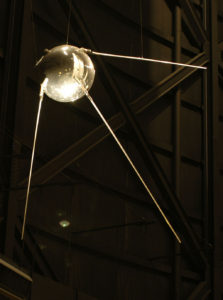Good morning, Whitewater.
Tuesday in town will be partly cloudy with a high of seventy-four. Sunrise is 6:57 AM and sunset 6:29 PM, for 11h 32m 12s of daytime. The moon is a waxing crescent with 10.4% of its visible disk illuminated.
Common Council meets tonight at 6:30 PM.
Sputnik 1 … “Satellite-1”, or ??-1 [“PS-1″… “Elementary Satellite 1”])[3] was the first artificial Earth satellite. The Soviet Union launched it into an elliptical low Earth orbit on 4 October 1957. It was a 58 cm (23 in) diameter polished metal sphere, with four external radio antennae to broadcast radio pulses. It was visible all around the Earth and its radio pulses were detectable. This surprise success precipitated the American Sputnik crisis and triggered the Space Race, a part of the larger Cold War. The launch ushered in new political, military, technological, and scientific developments.[4][5]
Sputnik itself provided scientists with valuable information, even though it wasn’t equipped with sensors, by tracking and studying the satellite from Earth. The density of the upper atmosphere could be deduced from its drag on the orbit, and the propagation of its radio signals gave information about the ionosphere.
Sputnik 1 was launched during the International Geophysical Year from Site No.1/5, at the 5th Tyuratam range, in Kazakh SSR (now known as the Baikonur Cosmodrome). The satellite travelled at about 29,000 kilometres per hour (18,000 mph; 8,100 m/s), taking 96.2 minutes to complete each orbit. It transmitted on 20.005 and 40.002 MHz,[6] which were monitored by amateur radio operators throughout the world.[7] The signals continued for 21 days until the transmitter batteries ran out on 26 October 1957.[8] Sputnik 1 burned up on 4 January 1958, as it fell from orbit upon reentering Earth’s atmosphere, after travelling about 70 million km (43.5 million miles) and spending three months in orbit.[9]
JigZone‘s puzzle for Tuesday is of a chain and sprocket:

